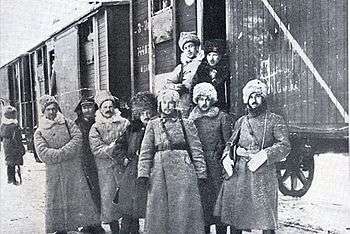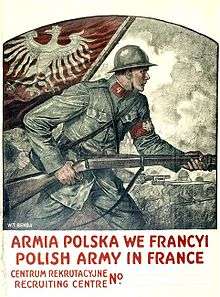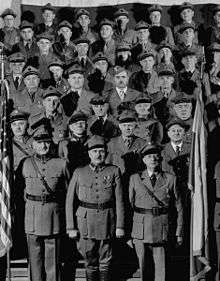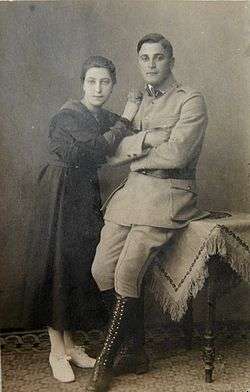Blue Army (Poland)
| Blue Army Haller's Army | |
|---|---|
|
Blue Army troops and General Józef Haller, c.1918 | |
| Active | 1917–21 |
| Country |
|
| Branch | Polish Legions |
| Size | 68,500 |
| Engagements |
World War I |
| Commanders | |
| General | Józef Haller von Hallenburg |
The Blue Army (Polish: Błękitna Armia), or Haller's Army was a Polish military contingent created in France during the latter stages of World War I. The name came from the blue military uniforms worn by the soldiers. The symbolic term used to describe the troops was subsequently adopted by General Józef Haller von Hallenburg himself to represent all newly organized Polish Legions fighting in western Europe.
The army was formed on 4 June 1917 and composed of Polish volunteers serving alongside the allied forces in France. After fighting on the Western Front during World War I, the army was transferred to Poland where it joined other Polish military formations fighting for the return of Poland's independence.
The Blue Army played a pivotal role in ensuring Polish victory in the Polish-Ukrainian War.
Haller's troops subsequently took part in Poland's defeat of the advancing Bolshevik forces during the Polish–Soviet War.
During the fighting on the Ukrainian front, individual soldiers within the ranks of the Blue Army acting on their own initiative but with the knowledge of their officers attacked numerous segments of the local Jewish population.[1][2][3] According to the joint Anglo-American Investigating Commission and resulting 1919 Morgenthau Report, attacks resulted from "widespread anti-Semitic prejudice aggravated by the belief that the Jewish inhabitants were politically hostile to the Polish State."[4] In parts of Western Ukraine, local Jewish authorities openly mobilized personnel to serve in the Ukrainian Galician Army.[5]
History
Background
%2C_concerned_by_France_as_provisional_Polish_goverment.jpg)
The emergence of the Blue Army was closely associated with the American entry into World War I in April, 1917. A month earlier, Ignacy Paderewski submitted a proposal in the U.S. House of Representatives to accept Polish-American volunteers for service on the Western Front in the name of Poland's independence. Some 24,000 Poles were taken in (out of 38,000 who applied)[6] and after a brief military training, they were sent to France to join General Haller,[7] including many women volunteers (PSK). Polish-Americans were eager to fight for freedom and the American-style democracy because they themselves escaped persecution by the empires who partitioned Poland a century earlier.[8] When the war erupted, the American Polonia created the Polish Central Relief Committee to help with the war effort, although ethnically Polish volunteers arrived in France from all Polish diasporas at the same time numbering over 90,000 soldiers eventually.[6] The Entente responded in kind by recognizing the Polish National Committee formed in France (led by Dmowski) as Poland's interim government, with Wilson's written promise (issued on 8 January 1918) to recreate sovereign Polish state after their victory. Poland's long-term occupier, the Tsarist Russia, got out of the war as first, overrun by the Bolsheviks who signed a treaty in Brest-Litovsk on 3 March 1918. The imperial Germany surrendered in the 11 November 1918 armistice.[7]
The Blue Army was formally merged into the Polish Army after the Armistice between the Allies and Germany.[6] Meanwhile, three interim Polish governments emerged independently of each other. A socialist government led by Daszyński was formed in Lublin. The National Committee emerged in Kraków. Daszyński (lacking support)[9] decided to join forces with Piłsudski who was just released by the Germans from Magdeburg. On 16 November 1918 Poland declared independence.[7] A decree defining the new republic was issued in Warsaw on 22 November 1918. A month later Paderewski joined in from France. At about the same time, heavily armed Ukrainians from the Sitchovi Stril'ci (Sitch Riflemen) seized the city of Lwów, and the battle for the control of the city erupted against the Piłsudski's legionaries.[9] It was a high-stakes gamble with all sides attempting to set a new reality on the ground ahead of the European peace conference in Versailles of January, 1919. Similar Polish uprisings erupted in Poznań on 27 December 1918,[9] Upper Silesia in August, 1919 than again in 1920 and May, 1921 — separated by the ad-hoc (or outright illegitimate) plebiscites with trainloads of German agents acting as local inhabitants.[7] In the spring of 1919, the Blue Army (no longer needed in the West) was transported to Poland by train. The German forces were very slow to withdraw.[9] In all, some 2,100 soldiers of the Blue Army who enlisted in France from the Polish diasporas died in the fighting including over 50 officers serving with Haller. Over 1,600 men were wounded.[6] The Haller's army included 25,000 ethnic Poles drafted against their will by the German and Austrian armies, out of 50,000 conscripts from across the partitioned Poland. They joined Haller from the POW camps in Italy in 1919.[9] The final borders of Poland were set only in October, 1921 by the League of Nations.[7]
Western Front

The first divisions were formed after the official signing of a 1917 alliance by French President Raymond Poincaré and the Polish statesman Ignacy Jan Paderewski. The majority of the recruits approximately 35,000 of them were either Poles serving in the French Army or former captured Polish prisoners of war, who were conscripted and forced to serve in the German Heer and Austrian Imperial-Royal Landwehr armies. Many other Poles also joined from all over the world—these units included recruits from the United States with an additional 23,000 Polish-American volunteers, and former troops of the Russian Expeditionary Force in France. Members of the Polish diaspora community in Brazil joined the army with more than 300 men volunteering as well.
The Blue Army was initially placed under direct French military control and commanded by General Louis Archinard. However, on 23 February 1918 political and military sovereignty was granted to the Polish National Committee and soon thereafter the army was directly commanded by independent Polish authorities. Also, more units were formed, most notably the 4th and 5th Rifle Divisions in Russia. On 28 September 1919 Russian government officials formally signed an agreement with the Entente that officially recognized the Polish military units in France as "the only independent, allied and co-belligerent Polish army". On 4 October 1918 the National Committee appointed General Józef Haller von Hallenburg as chief commander of the Polish Legions in France.
The first unit to enter combat on the Western Front was the 1st Rifle Regiment (1 Pułk Strzelców Polskich) fighting from July, 1918 in Champagne and the Vosges mountains. By October the entire 1st Rifle Division had joined the campaign around the area of Rambervillers and Raon-l'Étape.
Transfer to Poland

The army continued to gather new recruits after the end of World War I. Many of these new volunteers were ethnic Poles who were conscripted into the German, Austrian and Russian armies, and later discharged following the signing of the armistice agreement on 11 November 1918 . By early 1919, the Blue Army numbered 68,500 men and was fully equipped by the French government. After being denied permission by German officials to enter Poland via the Baltic port city of Danzig (Gdańsk) transportation was arranged via rail. Between April and June of that year, all the army units were moved to a newly independent Poland, across Germany in sealed train cars. Weapons were secured in separate compartments and kept under guard to appease German concerns about a foreign army traversing its territory. Immediately after its arrival, the divisions were integrated into the regular Polish Army and sent to the front lines to fight in the Polish-Ukrainian War, which was being contested in eastern Galicia.
The perilous journey from France (through revolutionary Germany) to Poland in the spring of 1919 has been documented by those who lived through it.
Captain Stanislaw I. Nastal: Preparations for the departure lasted for some time. The question of transit became a difficult and complicated problem. Finally after a long wait a decision was made and officially agreed upon between the Allies and Germany.
The first transports with the Blue Army set out in the first half of April, 1919. Train after train tore along though Germany to the homeland, to Poland.[10]
Major Stefan Wyczolkowski: On 15 April 1919 the regiment began its trip to Poland from the Bayon railroad station in four transports, via Mainz, Erfurt, Leipzig, Kalisz, and Warsaw, and arrived in Poland, where it was quartered in individual battalions; in Chełm 1st Battalion, supernumerary company and command of the regiment; 3rd Battalion in Kowel; and the 2nd Battalion in Wlodzimierz.[11]
Major Stanislaw Bobrowski: On 13 April 1919 the regiment set out across Germany for Poland, to reinforce other units of the Polish army being created in the homeland amid battle, shielding with their youthful breasts the resurrected Poland.[12]
Major Jerzy Dabrowski: Finally on 18 April 1919 the regiment’s first transport set out for Poland. On 23 April 1919 the leading divisions of the 3rd Regiment of Polish Riflemen set foot on Polish soil, now free thanks to their own efforts.[13]
Lt. Wincenty Skarzynski: Weeks passed. April, 1919 arrived – then plans were changed: it was decided irrevocably to transport our army to Gdańsk instead by trains, through Germany. Many officers came from Poland, among them Major Gorecki, to coordinate technical details with General Haller.[14]
After World War I

Haller's troops changed the balance of power in Galicia and Volhynia. Their arrival allowed the Poles to repel the Ukrainians and establish a demarcation line at the river Zbruch on 14 May 1919. The Blue Army was equipped by the Western Allies, and supported by experienced French officers specifically ordered to fight against the Bolsheviks, but not the forces of the Western Ukrainian People's Republic. Despite the diplomatic conditions, the Poles dispatched Haller's Army against the Ukrainians first, instead of the Bolsheviks. The tactical initiative was done in order to break the stalemate in eastern Galicia. In response, the allies sent several telegrams ordering the Polish government to halt its offensive, as using the allied-equipped army against the Western Ukrainian People's Republic specifically contradicted the status of the French military advisors, but the demands were ignored,[15] with Poles remarking that "all Ukrainians were Bolsheviks".[16]
In July, 1919 the Blue Army was transferred to the border with Germany in Silesia, where it prepared defensive positions against a possible German invasion of Poland from the west.
Haller's well trained and highly motivated troops — as well as their British build Bristol F.2 reconnaissance planes, Italian made Ansaldo A.1 Balilla fighters and French FT-17 tanks — also played a significant role in the ensuing Polish-Bolshevik War.
Postwar
The Blue Army's 15th Infantry Rifle Regiment formed a basis for the 49th Hutsul Rifle Regiment (part of the 11th Carpathian Infantry Division) after the end of World War I.
During the Communist crackdown in Poland after World War II, most of the history related to the Polish-Soviet War and the Blue Army was censored, distorted and repressed by the Soviet authorities.
Anti-Jewish violence
The antagonism exhibited towards non-Polish ethnic groups by some of Haller's soldiers directly stemmed from earlier events of the Greater Poland Uprising when Poles rose up against German rule only to find out that the Jews in the region sided with the German authorities, a decision primarily based on economic factors.[17] Individual soldiers who targeted local Jewish and Ukrainian civilians believed that they were collaborating with Poland's enemies, either the Ukrainian Galician Army or Bolshevik Russia.[18] Some of the more significant incidents of abuse were inflicted by the Polish-American volunteers. It is likely that the cultural shock of finding themselves confronted by a multitude of unfamiliar ethnic, political and religious groups that inhabited Western Ukraine led to a feeling of vulnerability, that in turn provoked the violent outbursts. Encyclopaedia Judaica asserts that because of its French ties the Blue Army enjoyed independence from the main Polish command and some of its soldiers exploited this when engaging in undisciplined action against Jewish communities in Galicia.[19]
In Częstochowa on 27 May 1919, a soldier by the name of Stanislaw Dziadecki who served in one of the Blue Army's rifle divisions was shot and wounded while on patrol. A Jewish tailor was suspected, and killed by civilians and Haller's soldiers on the street, after which Jewish homes and businesses were looted, by estimates between 5 and 10 Jews were killed, and a few dozen wounded.[20][21] According to historian Pavel Korzec, as the army traveled further east, some of Haller's soldiers as a way to exact retribution looted Jewish houses, pushed local Jews off moving trains and with their bayonets cut off the beards of Orthodox Jews.[22] Also, historian Alexander Victor Prusin stated that Haller's troops along with the Poznań regiments committed pogroms in Sambir, the area around Lviv and Grodek Jagiellonski; committing acts of rape, destroying prayer books and sacred scrolls in the synagogues,[17] however the latter sites do not appear in the Anglo-American Investigating Commission's Morgenthau Report, as locations where significant "excesses" occurred during the war.[23]
In an effort to curb the abuses, General Józef Haller himself issued a proclamation demanding that his soldiers stop cutting off beards of Orthodox Jews.[24] Also, in due course individual soldiers involved in confirmed acts of antisemitism did receive punishment for their abusive actions. To counter some of the false or exaggerated claims of antisemitism that were reported by the press, Polish Government officials supported by French intelligence noted that many of the alleged antisemitic tracts attributed to the Blue Army were in fact a product of willful disinformation based purely on hearsay and confabulation emanating from Russian and German government sources in an effort to discredit the new Polish Government, and in the process weaken the much needed Allied support for the new Polish State.[3] One of the sources identified in the disinformation campaign was the German consul in Bern, Switzerland — Franz von Tattenbach who advocated the increased use of propaganda about anti-Jewish pogroms in Galicia to weaken Poland's claims in the region.[3]
According to historian Howard Sachar, in the year and a half prior to the Blue Army's arrival the total number of Jewish casualties in the region was between 400 and 500, with Haller's troops doubling this number.[25] The Morgenthau Report estimated that the total number of Jews killed did not exceed 200-300.[4] As a result of the Blue Army's activities, General Haller's visit to the United States was met with protests from American Jewish and Ukrainian communities.[26][27] The character of Jewish losses was described by sociologist Tadeusz Piotrowski as minimal in comparison to the number of Poles and Ukrainians killed in the region, and that in most cases it was impossible to disentangle gratuitous antisemitism from commonplace looting and brutality of the soldiery. Also, the application of the term "pogrom" in the accepted sense of the deliberate lynching of Jewish civilians could not be applied to the great majority of the incidents which occurred.[28]
Historian William W. Hagen wrote that the Blue Army carried out pogroms in Lviv on 21 November 1918 and in Lida on 14 April 1919.[29] However, other historians note that the first units of the army did not leave France until 15 April 1919.[30][31][32]
Personnel

Veteran status of Polish-American volunteers
After the war, the Polish-American volunteers who served within Haller's Army were not recognized as veterans by either the American or Polish governments. This led to friction between the Polish community in the United States and the Polish government and resulted in the subsequent refusal by Polish-Americans to again help the Polish cause militarily.[33]

Jewish volunteers
Despite examples of violence perpetrated against segments of the local Jewish population by some troops within the Blue Army,[22][34][35] Polish Jews enlisted and fought alongside ethnic Poles serving as soldiers, doctors and nurses.[34] Some even received an officer's commission and took up leadership positions. Jews serving in the Blue Army's 43rd Regiment of Eastern Frontier Riflemen were listed as combat fatalities and researcher Edward Goldstein has estimated that five percent of the unit's battle casualties may have had Jewish backgrounds.[34]
Notable persons
Ludwik Marian Kaźmierczak, the paternal grandfather of the German chancellor Angela Merkel,[36] and an ethnic Pole born in Posen (Poznań), German Empire served in the Blue Army. During World War I, he was drafted into the German Army in 1915 and fought on the western front. After being taken as a prisoner of war in France, he joined the Blue Army, and subsequently fought in the Polish-Ukrainian and Polish-Soviet wars. After ending his service Kaźmierczak immigrated back to Germany.[37][38]
Order of battle
- I Polish Corps
- 1st Rifle Division
- 2nd Rifle Division
- 1st Heavy Artillery Regiment
- II Polish Corps
- III Polish Corps
- 3rd Rifle Division
- 6th Rifle Division
- 3rd Heavy Artillery Regiment
- Independent Units
- 7th Rifle Division
- Training Division - cadre
- 1st Tank Regiment
See also
Bibliography
- M. B. Biskupski, "Canada and the Creation of a Polish Army, 1914-1918," Polish Review (1999) 44#3 pp 339–380
- Joseph T. Hapak, "Selective service and Polish Army recruitment during World War I," Journal of American Ethnic History (1991) 10#4 pp 38–60[39]
- Paul Valasek, Haller's Polish Army in France, Chicago, 2006
References
- ↑ "Encyclopedia Judaica: Haller's Army". Encyclopedia Judaica. Retrieved 5 October 2015.
Haller's army ("Blue Army"), force of Polish volunteers organized in France during the last year of World War I, responsible for the murder of Jews and anti-Jewish pogroms in Galicia and the Ukraine… Foreign officers and the ties with France kept Haller's forces independent of the official Polish command, a fact exploited by Haller's soldiers (called the "Hallerczycy") for undisciplined and unbridled excesses against Jewish communities in Galicia. Attacks on individual Jews on the streets and highways, murderous pogroms on Jewish settlements, and deliberate provocative acts became commonplace. While these may have been on the initiative of individual soldiers, they were known to their officers, if not openly supported by them. In 1920, during the Polish offensive toward Kiev resulting from the Pilsudski-Petlyura alliance, anti-Jewish pogroms occurred in the region.
- ↑ Heiko Haumann (2002), A History of East European Jews. Central European University Press; pg. 215, via Google Books. Notes not included.
- 1 2 3 Carole Fink (2006), Defending the Rights of Others: The Great Powers, the Jews, and International Minority Protection, 1878-1938. Cambridge University Press; pg. 227, via Google Books.
- 1 2 "Full text of "The Jews in Poland : official reports of the American and British Investigating Missions"". Cornell University Library. Retrieved 24 November 2015.
- ↑ Alexander Victor Prusin (2005). Nationalizing a Borderland: War, Ethnicity, and Anti-Jewish Violence in East Galicia, 1914-1920. Tuscaloosa, AL: University of Alabama
- 1 2 3 4 Melvin Ember; Carol R. Ember; Ian Skoggard (2005). Encyclopedia of Diasporas: Immigrant and Refugee Cultures Around the World. Volume I: Overviews and Topics; Volume II: Diaspora Communities. Springer Science & Business Media. p. 260. ISBN 978-0-306-48321-9. Retrieved 25 November 2015.
- 1 2 3 4 5 Halik Kochanski (2012). The Eagle Unbowed. Harvard University Press. pp. 5–9.
- ↑ Anna D. Jaroszynska-Kirchmann (2013). Polish American Press, 1902–1969. Lexington Books. pp. 464–.
- 1 2 3 4 5 William Fiddian Reddaway (1971). The Cambridge History of Poland. CUP Archive. pp. 477–.
- ↑ The Blue Division, Stanislaw I. Nastal, Polish Army Veteran’s Association in America, Cleveland, Ohio 1922
- ↑ Outline of the Wartime History of the 43rd regiment of the Eastern Frontier Riflemen, Major Stefan Wyczolkowski, Warsaw 1928
- ↑ Outline of the Wartime History of the 44th Regiment of Eastern Frontier Riflemen, Major Stanislaw Bobrowski, Warsaw 1929
- ↑ Outline of the Wartime History of the 45th Regiment of Eastern Frontier Infantry Riflemen, Major Jerzy Dabrowski, Warsaw 1928
- ↑ The Polish Army in France in Light of the Facts, Wincenty Skarzynski, Warsaw 1929
- ↑ Watt, R. (1979). Bitter Glory: Poland and its fate 1918-1939. New York: Simon and Schuster.
- ↑ Subtelny, op. cit., p. 370
- 1 2 Alexander Victor Prusin (2005). Nationalizing a Borderland: War, Ethnicity, and Anti-Jewish Violence in East Galicia, 1914-1920. Tuscaloosa, AL: University of Alabama Press. p. 103. ISBN 0817314598.
Note: the exact phrase 'Blue Army' is not being used inside this book. It refers to it as Haller's Army
- ↑ Joanna B. Michlic. (2006). Poland's threatening other: the image of the Jew from 1880 to the present . University of Nebraska Press, pg. 117
- ↑ Moshe Landau (2007). Encyclopedia Judaica. Macmillan Reference Detroit, USA. Volume 8.
- ↑ Carole Finke. (2006). Defending the Rights of Others The Great Powers, the Jews, and International Minority Protection, 1878–1938. Cambridge: Cambridge University Press, pg. 230
- ↑ Marija Wakounig (28 November 2012). From Collective Memories to Intercultural Exchanges. LIT Verlag Münster. p. 196. ISBN 978-3-643-90287-0.
- 1 2 Pavel Korzec. (1993). Polish-Jewish Relations During World War I. In Hostages of modernization: studies on modern antisemitism, 1870-1933/39, Volume 2 Herbert Strauss, Ed. Walter de Gruyter: pp.1034-1035
- ↑ David Engel. Poles, Jews, and Historical Objectivity. Slavic Review, Vol. 46, No.3/4 (Autumn - Winter, 1987), pp. 568-580. See also Mission of The United States to Poland, Henry Morgenthau, Sr. Report
- ↑ American Jewish Committee.(1920). American Jewish year book, Volume 22 . Jewish Publication Society of America pg. 250
- ↑ Howard M. Sachar. (2007). Dreamland: Europeans and Jews in the Aftermath of the Great War, Random House LLC: page 25.
- ↑ General Haller's Visit to Boston Curtailed Jewish Telegraphic Agency. November 27, 1923
- ↑ Bnai Brith of Boston Decry Reception to Haller Jewish Telegraphic Agency. November 13, 1923
- ↑ Tadeusz Piotrowski. (1998). Poland's Holocaust: Ethnic Strife, Collaboration with Occupying Forces and Genocide in the Second Republic, 1918-1947, McFarland: page 43.
- ↑ William W. Hagen. Murder in the East: German-Jewish Liberal Reactions to Anti-Jewish Violence in Poland and Other East European Lands, 1918–1920. Central European History, Volume 34, Number 1, 2001 , pp. 1-30. Page 8.
- ↑ Kay Lundgreen-Nielsen, The Polish problem at the Paris Peace Conference: a study of the policies of the Great Powers and the Poles, 1918-1919, pg. 225, Odense University Press, 1979
- ↑ William Fiddian Reddaway, ed. (1941). The Cambridge History of Poland. J. H. Penson, O. Halecki, R. Dyboski. Cambridge University Press Archive. p. 477. GGKEY:2G7C1LPZ3RN. Retrieved 25 November 2015.
- ↑ Andrzej Nowak, Kronika Polski Kluszczynski Publishers, 1998
- ↑ Martin Conway, José Gotovitch. (2001). Europe in exile: European exile communities in Britain, 1940-1945. Berghahn Books pg. 191
- 1 2 3 Goldstein, Edward. Jews in Haller's Army. The Galitzianer, the quarterly journal of Gesher Galicia, May 2002.
- ↑ Heiko Haumann. (2002). A history of East European Jews Central European University Press, pg. 215
- ↑ Kanzlerin Angela Merkel ist zu einem Viertel Polin, Die Welt
- ↑ All in the Family: Chancellor Merkel's Heritage Pleases Poles, Der Spiegel
- ↑ Merkel's Polish roots emerge in new book, The Local
- ↑ Stanley R. Pliska, "The 'Polish-American Army' 1917-1921," The Polish Review (1965) 10#1 pp 46-59.
External links
| Wikimedia Commons has media related to Blue Army (Poland). |
- Haller Army Website
- Józef Haller and the Blue Army
- "The Polish Army in France: Immigrants in America, World War I Volunteers in France, Defenders of the Recreated State in Poland" by David T. Ruskoski http://scholarworks.gsu.edu/history_diss/1/
- "A World War 1 Experience; Believe It Or Not"
